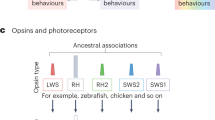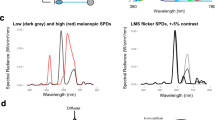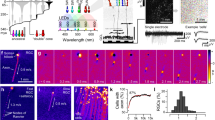Abstract
THE grey squirrel (Sciurus carolinesis leucotis) was initially considered to have an all-cone retina, based on evidence obtained by light microscopy1,2 and electroretinography2. In support of this, a difference spectrum obtained by reflexion densitometry was found to peak at 535 mµ3. Afterwards a difference spectrum of a photopigment extracted from this retina peaked at 504 mµ, however, and resembled rhodopsin4. Thereafter a group of diurnal squirrels including the grey squirrel was found to have double-peaked ERG spectral sensitivity curves, suggesting that there was more than one receptor mechanism in these retinæ5. Similar ERG results have been reported for other diurnal squirrels6,7. Recently, conditioning experiments on the grey squirrel demonstrated a peak wave-length sensitivity at 502 mµ (ref. 8), and rod-like in addition to cone receptors were found by electronmicroscopy9. This report shows that there are at least two receptor systems contributing to the grey squirrel's ERG which behave similarly to the rod and cone components of the ERGs of duplex retinæ.
This is a preview of subscription content, access via your institution
Access options
Subscribe to this journal
Receive 51 print issues and online access
$199.00 per year
only $3.90 per issue
Buy this article
- Purchase on Springer Link
- Instant access to full article PDF
Prices may be subject to local taxes which are calculated during checkout
Similar content being viewed by others
References
Walls, G., The Vertebrate Eye (Michigan, 1942).
Arden, G. B., and Tansley, K., J. Physiol., 127, 592 (1955).
Weale, R. A., J. Physiol., 127, 587 (1955).
Dartnall, H. J. A., Nature, 188, 475 (1960).
Tansley, K., Copenhaver, R. M., and Gunkel, R. D., Vision Res., 1, 154 (1961).
Crescitelli, F., Vision Res., 1, 139 (1961).
Dodt, E., Pflügers Arch. ges. Physiol., 275, 561 (1962).
Arden, G. B., and Silver, P. H., J. Physiol., 163, 540 (1962).
Cohen, A. I., Invest. Ophth., 3, 198 (1964).
Author information
Authors and Affiliations
Rights and permissions
About this article
Cite this article
GOURAS, P. Duplex Function in the Grey Squirrel's Electroretinogram. Nature 203, 767–768 (1964). https://doi.org/10.1038/203767a0
Published:
Issue Date:
DOI: https://doi.org/10.1038/203767a0
This article is cited by
-
Spectral mechanisms in the tree squirrel retina
Journal of Comparative Physiology A (1988)
-
Achromatopsia with amblyopia
Documenta Ophthalmologica (1974)
Comments
By submitting a comment you agree to abide by our Terms and Community Guidelines. If you find something abusive or that does not comply with our terms or guidelines please flag it as inappropriate.



